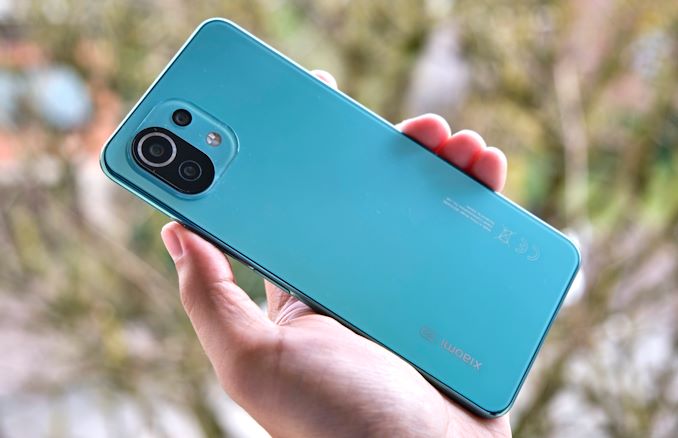Xiaomi Mi 11 Lite 5G Performance Report: First Taste of the Snapdragon 780G
by Andrei Frumusanu on April 13, 2021 9:00 AM ESTFirst Impressions & Conclusion
2020 had been a quite successful year for the Snapdragon 765 and it had seen usage in a lot of devices, some of which we reviewed or covered:
- The Google Pixel 5: A Mini-Review - Small Package, Small Value?
- OPPO's Reno3 5G vs Reno3 Pro vs Reno3 Pro 5G: Why Don't We See More MediaTek Dimensity 1000 Phones?
- The LG V60 and VELVET Review: A Classic & A Design Restart
The commonality between all of them was that while they promised the same features as the flagship counterparts that year, with a specific focus on 5G connectivity, the performance reminded us more of flagship devices of several generations ago. Sometimes I would wonder if it’s not actually better to purchase an older flagship device as in many cases the experience would have possibly ended up being better.
The new Snapdragon 780 goes a long way to resolve such performance discrepancies and bridging the gap to the current flagship generation. The performance uplifts to the Snapdragon 765G are quite massive, both in CPU and in particular GPU, resulting in a new end-user experience that is much different and much improved compared to the last generation.
Qualcomm also managed to achieve the performance uplifts all while improving energy efficiency, which is sometimes a hard balance to achieve when making big leaps like these.
We’ll be focusing on a review of the Mi 11 Lite 5G at a later date, but the device is a perfect example of what can be achieved with a Snapdragon 780G. At 369€ MSRP, the phone’s performance positions itself extremely competitively in terms of value proposition against flagship SoC devices, besides it being a breath of fresh air in terms of device design and form-factor.
In general, the Snapdragon 780 is a big leap forward for this device segment, much improving the device experiences you can expect from a “high mid-range” or “premium” range device, and should prove itself a solid foundation for many other 2021 devices.
Related Reading:
- Qualcomm Announces Snapdragon 780G: New 5nm 765 Successor
- Qualcomm Announces Snapdragon 768G: Higher-bin 765 up to 2.8GHz
- Qualcomm Announces Snapdragon 865 and 765(G): 5G For All in 2020, All The Details
- The Snapdragon 888 vs The Exynos 2100: Cortex-X1 & 5nm - Who Does It Better?
- Qualcomm Details The Snapdragon 888: 3rd Gen 5G & Cortex-X1 on 5nm












25 Comments
View All Comments
zentwo - Tuesday, April 13, 2021 - link
It has been suggested in some reviews that there is thermal throttling on the Mi 11 Lite 5G after around 5 minutes of benchmarking, while there is no throttling on the 4G version with the 732G. So it may be interesting to also test thermal throttling of this device.Andrei Frumusanu - Tuesday, April 13, 2021 - link
The sustained performance metrics in the GPU section are extended +30 minute throttling levels. There is a little bit of it but nothing substantial or problematic.Kangal - Wednesday, April 14, 2021 - link
Thanks Andrei for the review.I'm a bit surprised that Qualcomm released a chipset this fast and this efficient. Normally at this price point, I would've expected late 2022, as that's how slow Qualcomm's being with their mid-range chips. They must either be shifting strategy, being mindful of the competition, or something else.
The "something else" I feel like is ARMv9. There might be a divide coming, like there was during the 2014-2016 transition of 32bit and 64bit phones. It was particularly nasty from the software update path, when comparing Android 4.4 to 5.1
Any thoughts on that matter?
ZolaIII - Wednesday, April 14, 2021 - link
Midrange is 50% of all mobile SoC's sold and counts in for 70% of all mobile SoC's QC sells. Short answer is competition or better said higher tier of MTK Dimemsity SoC's. This way QC will stay at least one and a half steep ahead (better 5G and A78 core's).mekpro - Tuesday, April 13, 2021 - link
What is the cache size of this 780G ?Chaser - Tuesday, April 13, 2021 - link
Got to love progress. I am not a phone gamer. So a powerful midrange SoC like this one is very interesting.Linustechtips12#6900xt - Tuesday, April 13, 2021 - link
I love these new powerful midrange phones and chips, super power-efficient and I don't game or whatever besides some minor clash of clans or something like that stupid so it makes total sense to me rather than getting a phone with an sd888 and having worse battery life.KarlKastor - Tuesday, April 13, 2021 - link
@AndreiCan you say something to cache sizes and GPU clock?
Such data is available to the flag ship SoC, but never for the smaller ones.
Would be interesting for the 765, 750 and 730 too.
Wardrive86 - Tuesday, April 13, 2021 - link
I wonder if any of the GPU tests truly stress memory bandwidth. The Adreno 642(780G) outperforms the Adreno 640(855) in these benchmarks with half the memory bandwidth. As they are both Adreno 600 parts im assuming no new compression techniques are in use.iphonebestgamephone - Thursday, April 15, 2021 - link
Its only outperforming in the aztec normal test. I did some tests on my 855 device and got 44 and 17 fps on normal and high respectively. The sustained results are a matter of efficiency. Looks like the bandwidth doesnt matter much for benchea or games. 780g perfroms the same as 855 even in genshin impact.